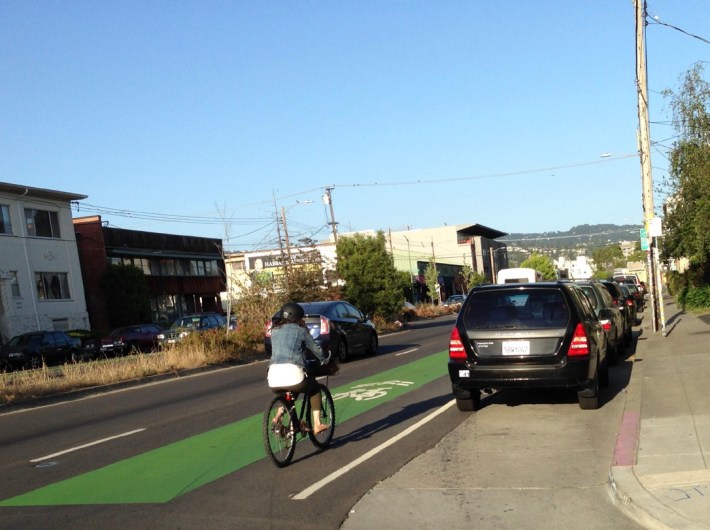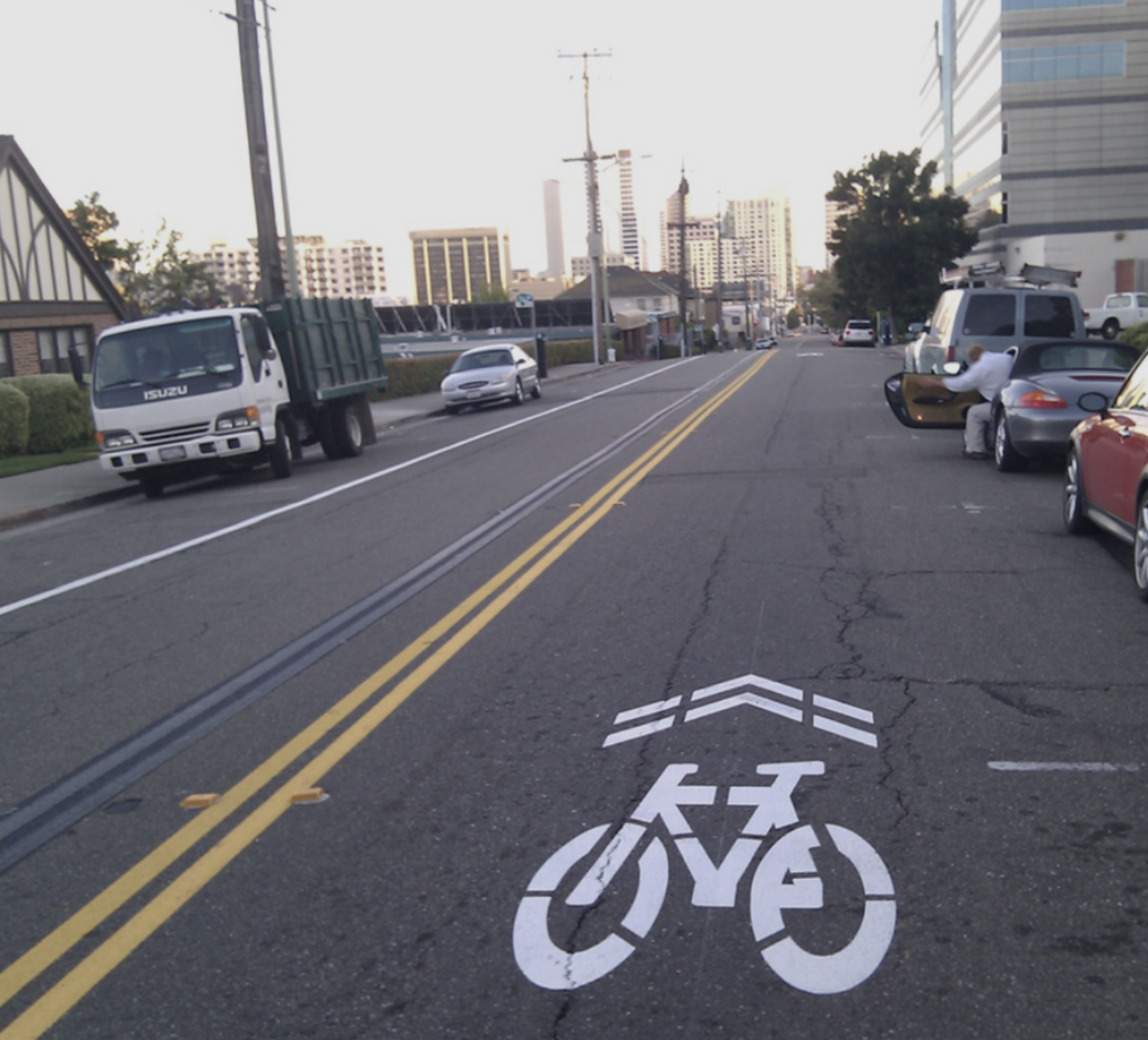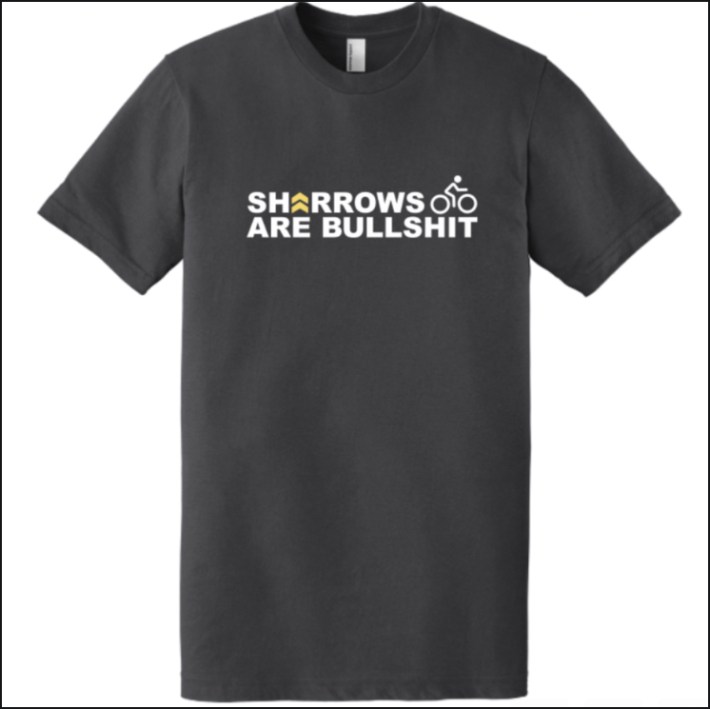It was the late 1990s and I thought we were so clever. We had just convinced the San Francisco Department of Parking and Traffic to incorporate an innovative new design into its bike plan, a bold statement conveying “bikes belong” right there in the middle of the street. I had first seen a shared-use marking, or “sharrow” — a white bicycle painted directly on asphalt — in photos of Paris and Chicago, put there to help bicyclists get through intersections by indicating their path of travel. In 1993, James McKay, a bike planner in Denver, used it on a trial basis to emphasize a bicyclist’s right to ride in the middle of the lane.
I was the young executive director of the San Francisco Bicycle Coalition. We published a hard-hitting newsletter and organized leaders from businesses, churches, community organizations, youth groups, and more into a coalition that was giving unprecedented voice to the demands of San Franciscans for safer streets. Looking to those examples from Chicago, Paris, and Denver, we pushed to get an improved version of the sharrow design formally included in the city’s bike plan and approved for use by the state of California. Mayor Willie Brown famously painted the first sharrow on Grove Street outside of City Hall, getting some green paint on his fancy suit and laughing it off in his inimitable style.
San Francisco went on to paint thousands of these symbols all over its bike network, and hundreds of cities followed suit. I thought the sharrow would educate bicyclists to stay out of the “door zone” and usher in a new era of safer streets, one where motorists would patiently wait behind bicyclists “taking the lane” because this painted symbol made it clear they had the right to do so. Where we couldn’t get a bike lane, I hoped this symbol would effectively convert the mixed-traffic lane into an adhoc bike lane when bicyclists were present.
I was wrong.
It turns out that motorists really don’t like to wait behind someone on a bike, regardless of the paint on the street. Even Oakland’s experiment with the so-called “super sharrow,” where the bicycle path of travel is painted solid green, isn’t enough to get people on bikes to comfortably “take the lane.” Sharrow or no sharrow, most people on bikes dangerously hug the edge of the roadway, squeezing themselves into the door zone to avoid blocking car traffic.
Simply put, sharrows don’t do what we hoped they would. Studies back up that claim.
Early research in San Francisco and Florida showed evidence that behaviors changed slightly on streets with sharrows. For example, some bicycle riders positioned themselves a few inches further from the curb or car doors. A 2010 evaluation of shared lane markings in three separate cities again showed that the markings had some positive impact on behavior. Looking closely at the results, however, it was clear the changes were too minor to make a difference. After Oakland’s experiment with the super sharrow, the Federal Highway Administration announced it would not support future experiments, and Oakland does not plan to continue the treatment when it repaves the street.
PETER FLAX: WHY SHARROWS ARE BULLSHIT
San Francisco still uses sharrows, but for the most part, city officials know better than to expect them to do much for safety. Today, beautiful sharrows point bicyclists along the circuitous path of the “wiggle,” where a right-left-right-left series of turns directs riders on a gentle grade between San Francisco’s steep hills. They are great for navigation and, perhaps, concentrating riders on certain streets — that’s about it.
It’s been more than 20 years since I had high hopes for the sharrow as a tool for safety. Today, we know so much more about what it takes to make our streets safer for bicycling. We need separate bike paths; we need protected bike lanes on busy roads; and where the lanes are shared, we need actual speedsreduced to 20 mph or slower. Sharrows don’t do any of that.

Sharrows do, however, accomplish something pernicious which I did not anticipate. They allow officials to take credit for doing something for bicycle safety without impacting car traffic, even though that something is next to nothing. It’s just pretending, and it’s worse than being honest about priorities. It’s insulting to the public to encourage bicycling by painting bike symbols on the street but doing nothing to actually make riding a bike any safer.
Yes, good bike infrastructure can require tradeoffs that are more politically challenging than simply painting a symbol on the street. Now, at PeopleForBikes, I’m part of a team that has successfully helped cities build networks of bikeways that actually get more people riding safely and joyfully. We help city leaders with communications, organizing, and political strategies to overcome the challenges they will surely face in building truly effective infrastructure.
We never suggest using sharrows to create a bikeway. We’ve learned our lessons. Now that we know better, it’s time to do more.
Dave Snyder, currently the senior director for infrastructure at PeopleForBikes, is the former executive director of the California Bicycle Coalition and was a key player in the proliferation of shared lane markings. Twenty years later, he’s disillusioned with them. This story was originally published on the PeopleForBikes website and is reprinted with permission.







